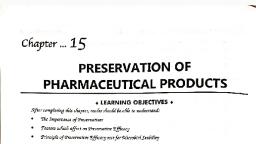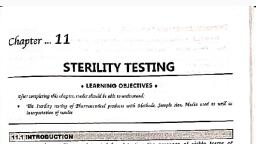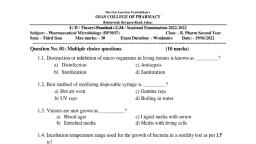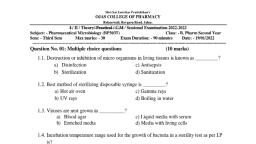Page 1 :
UNIT IV, , , , chapter .. 12, , ASEPTIC AREA AND, MICROBIAL CONTROL, , ¢ LEARNING OBJECTIVES «, After completing this chapter, reader should be abfe to understand:, , «© Preparation and Designing of Ascptic Arca, , © The Importance of Laminar Flow Equipments, , ® Contamination and Sources, , © Different Techniques for Preventation of Contamination and testing of Aseptic room, , , , , , , , , , , , 12.1 INTRODUCTION, , Aseptic techniques are used to prevent the access of microbial and particulate contamination into ophthalmic and parenteral products. Control of microbial contamination is also, necessary to eliminate pyrogens and toxic bacterial products. Terminally sterilized products, (product sealed in container and then sterilized) are prepared in a clean area. Products that, ae not terminally sterilized are aseptically prepared from sterile materials or sterilized by, filtration before being finally packed in sterile containers. Such aseptically prepared products, are required to be formulated or prepared in an aseptic area, An aseptic area is a room, within a clean area designed, constructed, serviced and used with the intention of, Preventing microbial contamination of the product., , Vaccines consisting of dead microorganisms, microbial extracts or inactivated viruses, May be filled in the same premises as other sterile medicinal products. Separate premises, ae needed for the filling of live or attenuated vaccines., , 12.2 DESIGNING OF ASEPTIC AREA, , Production of sterile products should be carried out in a clean environment with a limit, for the environmental quality of microbial and dust particle contamination, This limit for, Contamination is necessary to reduce the risk of product contamination. The production, atea Normally divided into the clean-up area, the compounding area, the aseptic area, the, Svarantine area and the packaging area. A process flow diagram of an aseptic area is given, "" Fig. 12.1. All these areas should be designed and constructed for ease of cleaning,, “cient operation, attractiveness and comfort of personnel., , (12.2)
Page 2 :
Pharmaceutical Microbiology (B.Pharm. Sem. DI) 12.2 Aseptic Area & Microbial Control, , , , , , , , , , , , jo}, Aifcs Aseplic ., Office + Conon |. pel BE na a, : } 3444+, ,, Stock room —j—» Clean - up —+ siertization — rand : a, contro!, , , , , , , , , , , , , , , , Fig. 12.1: Flow diagram of aseptic area, Clean areas for the production of sterile products are classified into grades A, B, C and D., These grades are categorized by the particulate quality of the environmental air when the, clean area is operating in both a ‘manned’ and ‘unmanned’ state, These areas are graded by, microbial monitoring of the environmental air, surfaces and operators when the area is, functioning, ., 12.2.1 Floors, Walls and Cellings, , All clean room surfaces including the floors, walls and ceilings must be smooth,, impervious, easily cleaned and disinfected and be constructed to minimize microbial and, Particulate contamination. Flexing and non-flexing types of materials are used for, construction of floors, Flexing floor materials are made of synthetic elastomers of which the, most commonly used are polyvinylchloride (non-slip grades). Polyvinylchloride flooring is, easily repaired, cleaned, relatively cheap and simple. Non-flexing floors are made of hard, inorganic filler substances in a matrix material. When concrete is used it must be adequately, sealed with a material resistant to chemicals, solvents and cleaning fluids., , Walls must be made of non-inflammable or fire-resistant materials e.g. stainless steel,, glass, enamelled steel etc. Generally, plaster walls are easily damaged by impact. For, reduction of fungal growth, 1% of 8-hydroxyquinoline, pentachlorophenol or salicylanilide, may be added to the paint. Epoxy resin paints and polyurethane paints are also used to, avoid cracking and peeling. The ceilings are sealed to prevent the entry of microbial, contaminants. Internal fittings such as cupboards, drawers, shelves and equipments must be, kept to a minimum., , 12.2.2 Doors, Windows and Services, , Doors and windows should fit flush with the walls. Windows, if required, are solely to, provide illumination and are not for ventilation. They should be non-openable, Doors should, be well fitted by maintaining positive pressure airflow and self-closing, There should be a, limited number of entry doors for personnel and ports for materials. Airlock doors, wall, ports, autoclaves and dry heat sterilizers should be fitted with interlocked doors.
Page 3 :
pharmaceutical Microbiology (B.Pharm. Sem. Im 12.3 Aseptic Area & Microbial Control, , All pipes passing through the walls of the room should be effectively sealed and should, be flush-fitting and easily cleaned. Gas cylinders should be excluded and all gases should be, piped from outside the area. Sinks and drains must be excluded from areas where aseptic, procedures are performed in clean room areas, Light sources in clean rooms are fitted with, the ceiling to reduce the collection of dust and to avoid disturbance to the airflow pattern, , within the room. Non-essential switches such as room lighting switches and isolators should, be installed outside the clean area,, , 12.2.3 Personnel and Protective Clothing, , The main source of contamination of clean areas arises from skin scales which are, released by the operators. Personnel selected to work on the preparation of a parenteral, product must be neat and reliable. They should be in good health and free from, dermatological conditions that might increase the microbial load. Operator-borne, contamination can be controlled by limiting the number of operators in the clean area,, restricting their movement, isolating them from the product and the environment with, , suitable protective clothing. All personnel should be trained for good manufacturing, practices and aseptic techniques., , Protective clothing is designed to prevent contamination from the body and everyday, clothing. They should be restricted to use in aseptic or clean areas only. All protective, clothing must be sterilized by moist heat sterilization or ethylene oxide sterilization. The, operator must wear sterile protective clothing including headwear, powder-free rubber or, plastic gloves, a non-fibre shedding facemask and footwear. Fresh sterile clothing should, normally be provided each time a person enters an aseptic area., , 12.2.4 Cleaning and Disinfection, , Cleaning and disinfection procedures are used for the removal of microbial and, Particulate contamination. Cleaning agents are the alkaline detergents and non-ionic and, ionic surfactants. Different types of disinfectants should be employed in rotation to prevent, the development of resistant strains of microorganisms. Different concentrations of, Quarternary ammonium compounds, sodium hypochloride, ethanol and formaldehyde, Solutions are used as disinfectants in clean areas. Cetrimide or chlorhexidine in 70% alcohol, are suitable for use as skin disinfectants., , [42.3 LAMINAR FLOW EQUIPMENTS., , Laminar air flow equipment can deliver clean air in a vertical, horizontal or curvilinear, direction, The construction and directions of a vertical and horizontal laminar airflow bench, are shown in Figure 12.2 and 12.3 respectively. The air filtered from laminar air flow is, Claimed to be 99.97% free from microbial contamination, This level is based upon the, Temoval of dioctylphthalate (DOP) particles of size 0.3 pm and larger. Air velocity at all parts, Of the filter should be 90 + 20 feet/min (0.54 m/sec.)
Page 4 :
Pharmaceutical Microbiology (8.Pharm. Sem. II) 12.4 Aseptic Area & Microbial Contro}, , 12.3.1 Air Supply, , The air supplied to a clean toom must be filtered through high-efficiency particulate air, (HEPA) filters. The HEPA filter must be positioned at the inlet for the clean room and prefilter may be fitted upstream of the HEPA filter to prolong the life of the final filter. In these, HEPA filters, a pleated fibre glass paper is used as the filter medium. The filter consists of a, , continuous sheet of filtration material, pleated with a corrugated separator placed between, each pleat and sealed into a rigid metal frame. Aluminium foil is used to form spacers in the, HEPA filter,, , , , (ew, Air diffusor, HEPA filter —_, Protective screen = eee 5, Fi SS MA, Light fixture a Loa, iY, Workl, surface, , , , , , Nae, , , , , , , , , , Fig, 12.2: Vertical laminar air flow bench, , Light fixture, , , , Protective screen, , Supply plenum, HEPA filter, , , , , , , , , , , , , , Air flow, , a - Working surface, Air intet be, , Pre - fiter, Blower, , , , , , , , , , , , , , Fig. 12.3: Horizontal laminar alr flow bench
Page 5 :
pharmaceutical Microbiology (B.Pharm. Sem.) 12.5 Aseptic Area & Microbial Control, , Quality control procedures must be adopted to evaluate and monitor the quality of the, HEPA filter. These filters are supported to provide class 100 air and they should be certified, after every 6 to 12 months, Air quality is evaluated using settle plates, microbial air samplers, and particle counters. The velocity of HEPA-filtered air is measured using an air velometer., The efficiency of the filter in removing particulate and microbial contamination is evaluated, by employing the dioctylphthalate (DOP) test., , This is a universally acceptable challenge test for HEPA filters. Dioctylphthalate smoke is, introduced at the supply plenum and a photometer probe scans the surface of the filter for, smoke particles. Dioctylphthalate is a volatile liquid and under pressure, it converts to, vapour or smoke having a size range of 0.3 to 0.4 pm. Leakage of the filter will permit the, dioctylphthalate particles to escape and this will be detected by the photometer. Sensors are, fitted upstream and downstream the filters to indicate the pressure differential across the, filter, An alarm system should be used to indicate failure in the air supply or filter blockage., , Direction of air flow in a horizontal laminar air flow is shown in Fig. 12.4., __—<—— HE filter, , , , , , , , , , , , , , , , , , , , , , , , , , , , , , UV light, Protective screen, a _—, i Air flow, —, fr -—T Working area, tr { — -——, Prefilter, “s Blower, , , , , , , , , , , , , , Fig. 12.4: Direction of air flow in a horizontal laminar air flow, , 12.3.2 Airflow Pattern, , The airflow pattern within the clean room must be carefully regulated to avoid, Senerating particles from the clean room floors, walls and operators. The general airflow, Patterns in clean rooms are unidirectional airflow, non-unidirectional airflow and, , Ombination airflow.

















































































